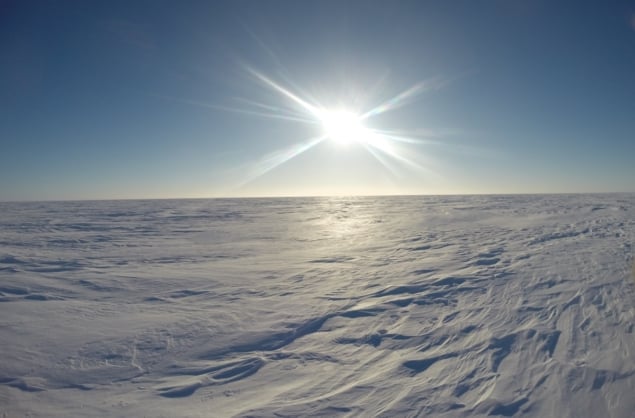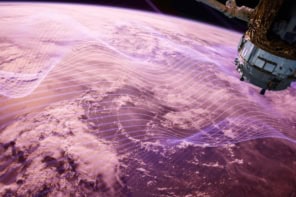
The distribution of snow on flat Arctic sea ice follows two distinct statistical patterns, suggesting that wind shapes the snowscape via two separate processes. A collaboration from Sweden, Canada, the UK and the US came to this conclusion after analysing correlations between snow thickness measurements over different length scales. The researchers propose that statistical patterns over distances of around 10 m represent dune formation, while interactions between snow dunes account for patterns at the 30–100 m scale. The results could help improve climate models, which do not fully account for the thickness and variability of snow cover on sea ice.
In the Arctic, fresh sea ice starts to form from around October. Before external stresses generate topographical features like cracks and pressure ridges, the ice is remarkably flat, and any unevenness in the snow that accumulates can only be due to the action of the wind. For this reason, first-year sea ice offers an ideal natural laboratory in which to test models of wind-blown snow distribution.
Woosok Moon, of Stockholm University and the Nordic Institute of Theoretical Physics, and colleagues found two sites where such conditions arose repeatedly over several years. At Dease Strait, near Cambridge Bay in northern Canada, they performed snow thickness measurements on first-year ice in the spring of 2014, 2016 and 2017. At Elson Lagoon on Alaska’s north coast, similar measurements were made in the spring of 2003 and 2006. The wind speed and direction were known at each site for the months preceding the measurements, so the researchers had a good record of the factors that determined how the snow accumulated there.
The team used nonlinear time-series analysis to characterize the statistical properties of the snow’s thickness over different length scales. As the distance between the measurements increased, they noticed a change in the statistical pattern that described the thickness fluctuations.
“We start by measuring the snow thickness in an area every 10 m, and then we do the same thing in another area. We find that the statistical characteristics of the two sets of measurements are very similar,” explains Moon. “But when we measure the thickness every 60 m instead, we see that this sample is different statistically from the 10-m sets.”
Usually, seeing such a change in the statistics of a system indicates that different phenomena govern the behaviour at each scale. Snow particles are transported by the wind in much the same way as sand grains are, and since the fluctuations in snow thickness at the 10-m length scale are similar to those seen in sand dunes, the researchers think that the same formation mechanism operates in both cases.
The cause of the statistics exhibited at longer measurement scales is more mysterious, but Moon and colleagues say that its noise characteristics mirror the self-organized criticality seen elsewhere in nature, such as in the distribution of different sizes of earthquakes along a geological fault line. This is the phenomenon whereby complex statistical patterns emerge from large numbers of simple interactions, which in this case are represented by the calving and merging of drifting snow dunes.
The complexities of snow accumulation in the Arctic are more than a statistical curiosity. Depending on the season, the snow layer can either promote or prevent the melting of sea ice. In the winter, thick snow acts as a blanket, trapping the ocean’s heat below and preventing the growth of new sea ice. In the spring and summer, the snow’s bright white surface reflects sunlight, keeping the ice frozen for longer – at least until melt ponds start to form, at which point the snow’s albedo drops and thawing accelerates.
“For proper quantification of the above physics, the most important properties of the snow are its thickness and its temporal and spatial evolution,” says Moon. “Now we understand the role of the wind on these properties, we can move to more complicated topographies and use our knowledge to better understand the influence of rugged surfaces.”
Moon and colleagues reported their findings in Environmental Research Letters.



